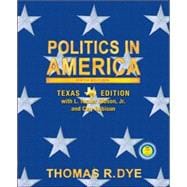
I. POLITICS.
II. CONSTITUTION.
III. PARTICIPANTS.
IV. INSTITUTIONS.
V. OUTCOMES.
Basic Version: Table of Contents as above for Chapters 1-15 only. No separate policy chapters in this version.
Texas Edition: Table of Contents as above plus these additional chapters concerning Texas politics:
19. The Social and Economic Milieu of Texas Politics.
20. The Texas Constitution.
21. Interest Groups, Political Parties, and Elections in Texas.
22. The Texas Legislature.
23. The Texas Executive and Bureaucracy.
24. The Texas Judiciary.
25. Local Government in Texas: Cities, Towns, Counties, and Special Districts.
Glossary.
The New copy of this book will include any supplemental materials advertised. Please check the title of the book to determine if it should include any access cards, study guides, lab manuals, CDs, etc.
The Used, Rental and eBook copies of this book are not guaranteed to include any supplemental materials. Typically, only the book itself is included. This is true even if the title states it includes any access cards, study guides, lab manuals, CDs, etc.